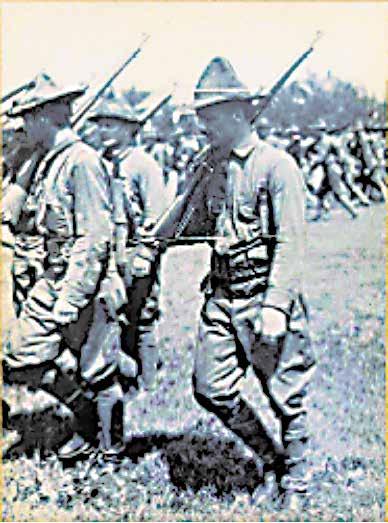
4 minute read
Historic Plattsburgh ROTC Program to Close
By Maj. Joe Notch
104th Training Division (LT)
Advertisement
PLATTSBURGH, Pa. — After nearly a century of preparing young citizens to become military leaders, the historic Army ROTC program at Plattsburgh State University College is closing its doors for good at the end of the 2014-15 school year due to a nationwide ROTC restructuring.
Although Plattsburgh ROTC was never a large program, it offered degrees at a tremendous costsavings to its Cadets and the Army – producing officers with similar degrees at tuition rates roughly onethird the cost of its full-partnership program, the University of Vermont (UVM). Cadets and Cadre warmly referred to their program as the “bluecollar alternative to UVM,” a slogan which also reflected the strong work ethic of its graduates, who in the last two years alone, all earned Active Duty commissions and either their first or second branch choices.
Despite its historic contributions to Army ROTC, the modern program did not come to Plattsburgh State University College until 2007, when interest from students demonstrated the potential for growing the Army’s wartime need for junior officers.
With the nearest ROTC campus just 20 miles away in Burlington, Vermont; the cities lie on opposing shores of the country’s sixth largest body of water, Lake Champlain. Fees and a 1.5 hour commute and ferry crossing were too impractical for prospective cadets to travel each day, so University of Vermont ROTC assigned Lt. Col.
Douglas Goodfellow of the Army
Reserve to run the Plattsburgh program as an Army ROTC contractor.
Starting the program with just 10 cadets, Goodfellow singlehandedly ran all aspects of the program, from drill and ceremony, physical fitness training, MSI-IV classes, labs, administration and recruiting events.
Within two years, the program grew to over 40 cadets and gained enough attention to garner support from the Army Reserve’s 4/415th SROTC Battalion, 104th
Training Division (LT), joined first by Maj. Chris Dobozy in 2009, Maj.
Joe Notch in 2010 and Maj. Dan
Gardner in 2012.
When initial ROTC restructuring caused Goodfellow’s reassignment to Clarkson
University in 2013, the Plattsburgh ROTC program was kept alive by the tireless efforts of just the three remaining 4/415th Battalion officers, who juggled full-time coverage of the program with rigorous careers as federal agent, pilot and as an assistant U.S. Department of Justice Attorney.
Modern ROTC rooted in the “Plattsburgh Movement”
The blueprint for modern ROTC began in Plattsburgh in 1913 as an addition to Land Grant colleges. Gen. Leonard Wood, Army chief of staff and President Theodore Roosevelt’s former commanding officer during the Spanish-American War, established two experimental military training camps for students, inaugurating the “Plattsburgh Movement.” For the first time in history, a condensed course prepared civilian professionals and college students as competent reserve line officers after only a summer of training.
Army Cadet Theodore (Teddy) Roosevelt marches while training at the Plattsburgh Camp. Courtesy photo Members of 4/415th Battalion, 3rd Brigade (SROTC), 104th Training Division (LT), pay tribute to ROTC at Plattsburgh State University College (PSUC). The Army is ending its ROTC program on campus at the end of the school year following nationwide SROTC restructuring. Pictured from left to right are Maj. Dan Gardner, Maj. Chris Dobozy, 2nd Lt. Bob Matzel, Lt. Col. (Ret.) Douglas Goodfellow and Maj. Joe Notch. Courtesy photo



Men volunteered to attend the camps at their own expense, paying for their own uniforms, transportation and subsistence. The summer training program provided a greatly expanded junior officers’ corps on the eve of WWI, but the regiments still had no official standing as part of the military. The National Defense Act of 1916 continued the student military training and summer camps, authorized an Officers’ Reserve Corps and a Reserve Officers’ Training Corps (ROTC) and commissioned graduates of these schools based on their performance.
The Plattsburgh program was a tremendous success, leading many universities to endorse oncampus military instruction as the best way to strengthen America’s military without the need for a standing army. By the end of 1917, over 17,000 men were trained at Plattsburgh, including three of President Theodore Roosevelt’s four sons. During WWI, 90% of all the Army’s line officers had trained at Plattsburgh or at similar facilities that cropped up in other locations. Under the Assistant Secretary of the Navy, Franklin D. Roosevelt, similar training for Naval officers was established at Plattsburgh and on select U.S. battleships.
To read more about Plattsburgh’s long list of significant contributions to the military please visit the 108th Training Command page at www.dvidshub.net.
Images from a Plattsburg Camp advertising campaign from World War I. Courtesy photo












